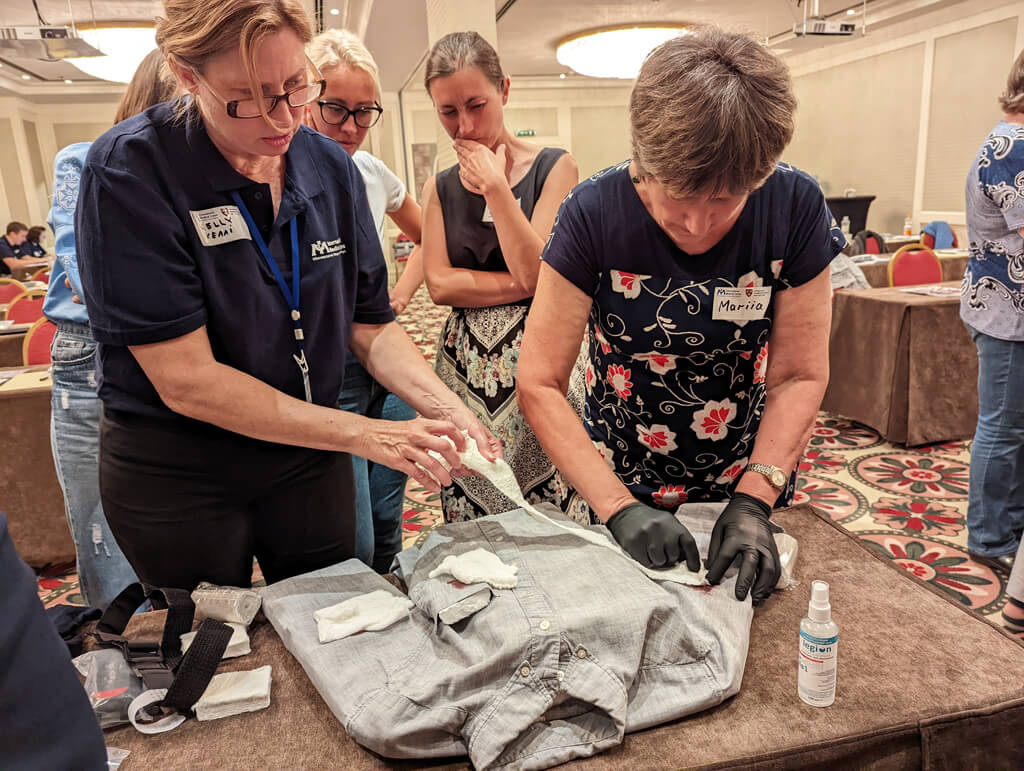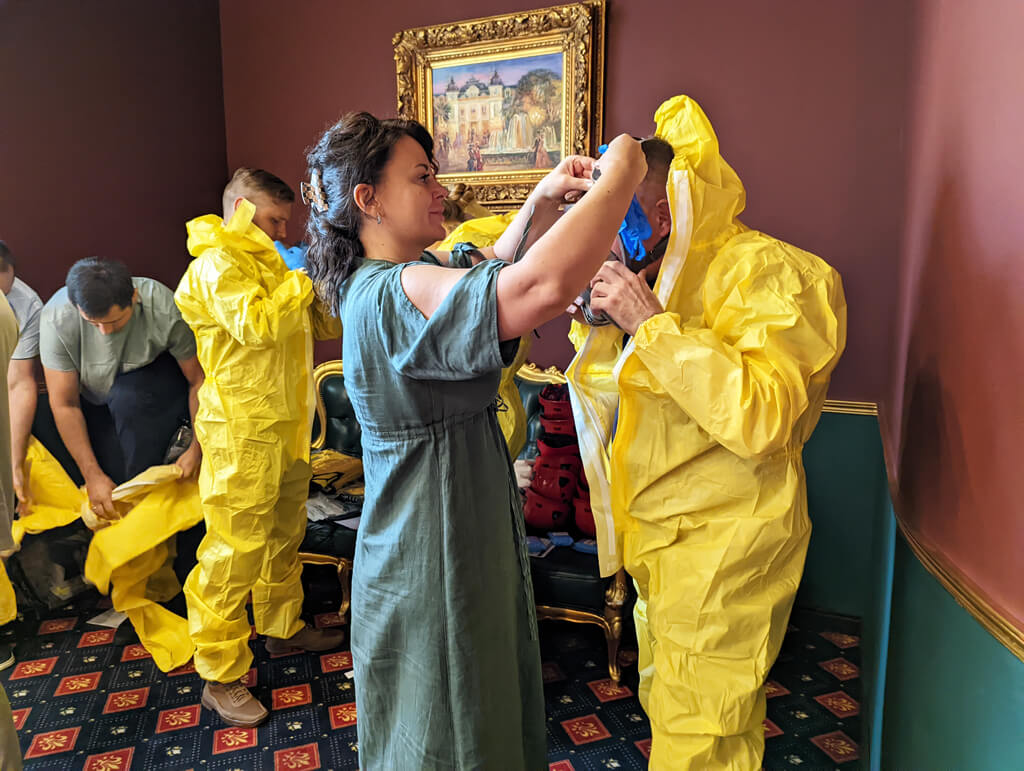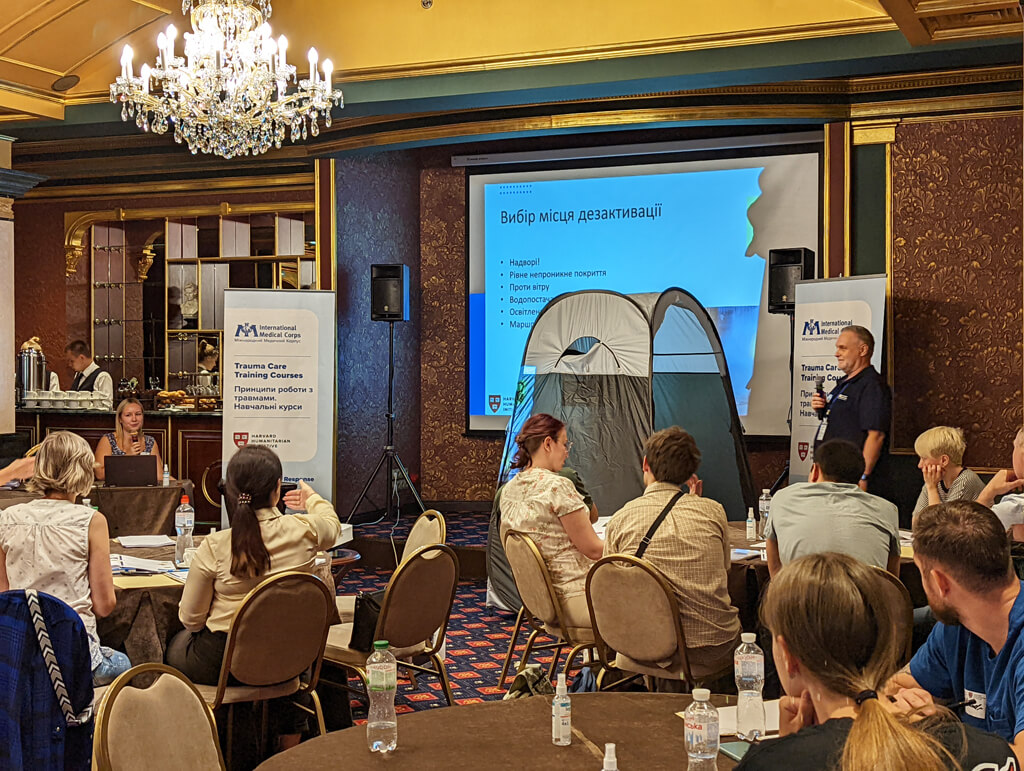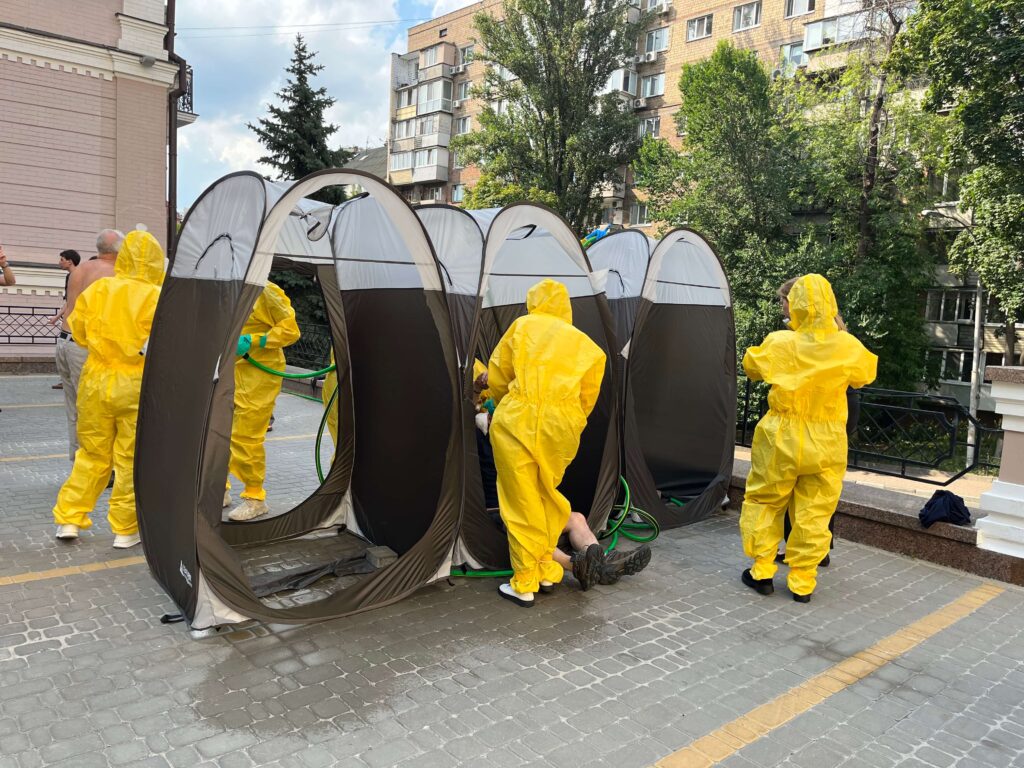Training has always been the cornerstone of our mission at International Medical Corps. In addition to providing emergency medical services during a conflict, disaster or disease outbreak, we focus on providing healthcare professionals and first responders with the skills and knowledge they need to provide long-term support to their communities. In 2021, we trained more than 77,000 people worldwide in different programs, including gender-based violence, mental health and psychosocial support, and water, sanitation and hygiene.
Training has been at the core of our work in Ukraine, too. We have been present in the Donbas region since 2014, and rapidly expanded our services throughout the country when the Russian invasion began on February 24, 2022. “As we continued to work there, various health authorities informed us that the medical workforce in the country was not equipped to treat some of the complex trauma cases it was receiving,” says Meaghan Sydlowski, a specialist in our emergency response unit (ERU) who was deployed to Ukraine. “The doctors and nurses did not anticipate the growing need for trauma care and treatment, because no one had imagined a full-scale war. There was room not only for clinical training but also for hospital-level preparedness.”

International Medical Corps partnered with the Harvard Humanitarian Initiative (HHI) to provide comprehensive emergency- and trauma-care training to healthcare workers, public safety professionals and the Ukrainian community. The first phase of the training program, which started in August 2022, lasted five months. During this phase, we trained more than 2,000 people across Ukraine. The second phase began in January 2023 and will conclude in April.
The training program comprises seven courses:
• Advanced Trauma Life Support Fundamentals
• Trauma Nursing Fundamentals (TNF)
• Pre-hospital Trauma Fundamentals (PHTF)
• Pediatric Trauma Fundamentals
• Stop the Bleed® (STB)
• Mass Casualty Management (MCM)
• Chemical, Biological, Radiological, Nuclear and Explosive (CBRNE)
We deployed volunteer nurses, doctors, paramedics and other specialists to teach the courses in different cities, starting in Kyiv and moving on to Chernihiv, Dnipro, Lviv, Odesa and Zaporizhzhia. Though the number of instructors varies with each course, we usually have one instructor for 10 participants. The curriculum is designed by experts in medicine, public health, education and communications. We have developed and implemented the training program in collaboration with HHI, the American College of Surgeons, the Emergency Nursing Association and the World Health Organization.
“Trauma is an area that is pretty important to learn, especially in situations like Ukraine,” explains Katie Biniki, Deputy Medical Coordinator and Program Lead for the trauma training. “We are not only teaching traumatologists with a specialty in trauma, but also general-practice doctors, nurses, paramedics and citizens at high risk of experiencing trauma.”
Something for Everybody to Learn
The number, age range and profession of participants in the training program vary widely. From teenagers to elderly people, from bus drivers to doctors and nurses, thousands of people have shown interest in learning “necessary skills in a war zone.” Though some participants enrolled in more than one course, many others who did not sign up for any course also participated. “One time, we were teaching at a pediatric hospital, and a lot of doctors and nurses just heard about the program,” says Katy Morris, a medical and disaster trainer who leads the TNF course. “They came by and signed up on the fly, so we got many more people than we expected, which is great.”
Caitlin Bartkus, who was deployed to Ukraine as part of the ERU, attributes the high turnout to the “thirst for knowledge” there. “Healthcare professionals are in high demand at their hospitals, but they thought it was worthwhile to set aside some time to attend our training sessions,” she says. This commitment really shines through in a story she shares about a training session following the Crimea bridge explosion. “The following day, we had to determine whether or not we should go back to Zaporizhzhia to continue with the training,” she recalls. “Zaporizhzhia was attacked by missiles that day, so some of our MCM trainees could not return, as they were dealing with mass casualty incidents at their health facilities. But our training team decided that if we had at least seven participants, it would be worthwhile to continue the training.” Exactly seven participants showed up for the MCM course that day. “At the end of the day, one of the instructors approached me and said, ‘The participants were so engaged. It would have been worth coming back for only one person, if he or she were as engaged as the rest of them,’” Bartkus says.

Morris has also taught the MCM course. “This course helps prepare hospitals and health facilities for what happens within the first 30 minutes to an hour of a mass casualty event,” she explains. “We do tabletop exercises, where participants draw the blueprint of their hospital and simulate a mass casualty incident, with patients coming in. They have to identify where they will put the patients and how they will manage them.” This helps hospital management develop an emergency plan if it does not already have one, or identify any gaps in its existing plan.
The STB course, while teaching bleeding-control techniques to the layperson, also serves as a refresher for doctors. “As an emergency doctor, I do a lot of hemorrhage control daily,” says Catalina Gonzalez-Marques, HHI faculty and Emergency Medicine Physician at Brigham and Women’s Hospital in Boston, Massachusetts. “But sometimes, you forget the basics. I love that STB goes through the basics of hemorrhage control that anybody can learn and perform.” She adds that in an active conflict zone, being able to control a hemorrhage if someone is injured can be a lifesaving skill. Bartkus agrees. “Anything can happen during a war, and you would want to be able to save somebody’s life if you need to,” she says. “So knowing how to apply a tourniquet—that we teach in STB—is helpful.”

Another relevant course is CBRNE—scenario-based training that combines lectures and hands-on activities. The instructors divide the participants into smaller groups and give each group a scenario. While some participants play victims, others act as first responders and as hospital staff receiving the patients. They first assess the situation and then go through all the mandatory steps, including decontamination and donning PPEs. “We want to make the training as real as possible,” says Bartkus. “So we provide participants with hazmat suits and gas masks. We also set up decontamination stations.”
Training of Trainers, and Expanding to Videos
A noteworthy aspect of the program is providing train-the-trainers sessions, which International Medical Corps conducts for CBRNE, STB and PHTF. “We have trained many local people, to enable them to teach these courses themselves,” Bartkus says, “and we left behind our training equipment in each of our locations so that the people we trained could continue to provide the training.” In fact, most of the trainers in the program’s second phase were participants in the first phase. “In the second phase, we have shifted the focus to national staff teaching the course themselves, instead of bringing in international experts,” says Biniki.

And in an effort to scale the program even further and, more importantly, provide access to those unable to attend the courses, HHI has produced a series of short YouTube videos. The videos, aimed at strengthening local health systems by providing high-quality, open-access content, can be used in real time as needed, or as refresher training for healthcare staff, public safety professionals and the general public.
The videos, which are less than five minutes each, are in Ukrainian with English subtitles, with transcripts available. The playlist covers many topics, including initial burn care, needle decompression, pediatric circulation, thoracostomy and CBRNE. When the complete series is posted, it will have 37 videos in total—35 videos of educational content and two videos giving an overview of the training program.
The video series so far has had more than 2 million views on YouTube and Facebook, with viewers based in more than 500 cities in Ukraine.
Flexibility is the Best Way to Navigate Challenges
Implementing the training program amid an ongoing war has presented challenges. Though the first few weeks went smoothly, “things became more difficult as we went further east,” says Sydlowski. In Dnipro, for example, public transportation would shut down during air raids, and sometimes participants would back out at the last minute, fearing an attack. On other occasions, explosions went off during the training. “In Zaporizhzhia, we had to move a training class to a bomb shelter in an underground car park,” recalls Morris. “We had to go back and forth to get our training material and mannequins, but it all worked out well in the end.”

One of the challenges was to adapt the training program to meet the requirements of the Ukrainian healthcare system. “When we started with the course, a lot of the content was based on trauma care practiced in the United States,” says Biniki. But the trauma care in Ukraine is quite different. “Such training is usually not given to every nurse or doctor as part of their medical training. So, a maternity nurse in Ukraine would only specialize in maternity care. As a result, there is not a lot of overlap in knowledge,” she explains. “To be able to develop a course that understands this difference and can train every type of health worker is commendable,” she says.
Logistics is another challenge. With the training being held in different cities, it has not been easy to coordinate among different teams. In addition, getting supplies and training material into the country or transporting them within Ukraine has been challenging. So the instructors have learned to be flexible. “When there was an attack on the first day of our training in Zaporizhzhia, the security team did not clear us to return the next day,” Morris says. “So we had an online class. And because of the security threat, we had to rearrange our schedule and adjust the duration of the training session.”

In other places, electricity was less reliable because of the attacks on the country’s energy infrastructure. “When we were teaching in Stryi, we lost power for a while. But we could not waste time waiting because the security situation was unpredictable. So we used our laptops and made do with whatever we had,” Morris adds. She acknowledges the commitment of the logistics team to make the training program successful. “The logistics team has been incredible,” she says. “It has secured locations, transportation and procurement to ensure we have everything we need.”
Dr. Gonzalez-Marques praises the security team, too. “Working in Ukraine today is not for the faint-hearted,” she says. “It is risky and stressful. But I felt at ease because of the security protocols in place. The security team assessed the situation carefully. Besides, International Medical Corps has a robust operation in Ukraine, and having a relationship of trust with the local authorities was an asset.”
Footprints of Friendship and Gratitude
Biniki has heard many participants say that they have never received training like what International Medical Corps provided in Ukraine. “We saw a deficit in trauma training in the country, and we responded,” she says.
Every participant and instructor has returned home with stories and beautiful memories. They have made new friends, who have now become like families. “When the invasion started, I didn’t know anyone in Ukraine,” says Morris. “A year later, it’s like I have a family there, and I always worry about their safety.” She recalls how a female participant walked up to her during the STB course and gave her a helix-shaped bracelet in the colors of the Ukrainian flag. “She said, ‘This is my Ukrainian DNA. I want you to have a piece of my DNA so that you remember me,’ and she tied the bracelet on my wrist, thanking me for the training we provided,” Morris says. Gestures like this by the Ukrainians have won over the hearts of our teams. Says Biniki, “It’s been an honor to work with them.”

“I was honored and humbled to be a part of this initiative,” says Kris Halliwell, a volunteer instructor for the STB and PHTF courses. “The connections made, the stories shared and the knowledge gained has moved me in a way I could have never anticipated.”
To find out more about our training videos, visit the Emergency and Trauma Care Training page on our website and subscribe to our YouTube channel. To find out more about our response, please visit our Ukraine emergency hub page.
